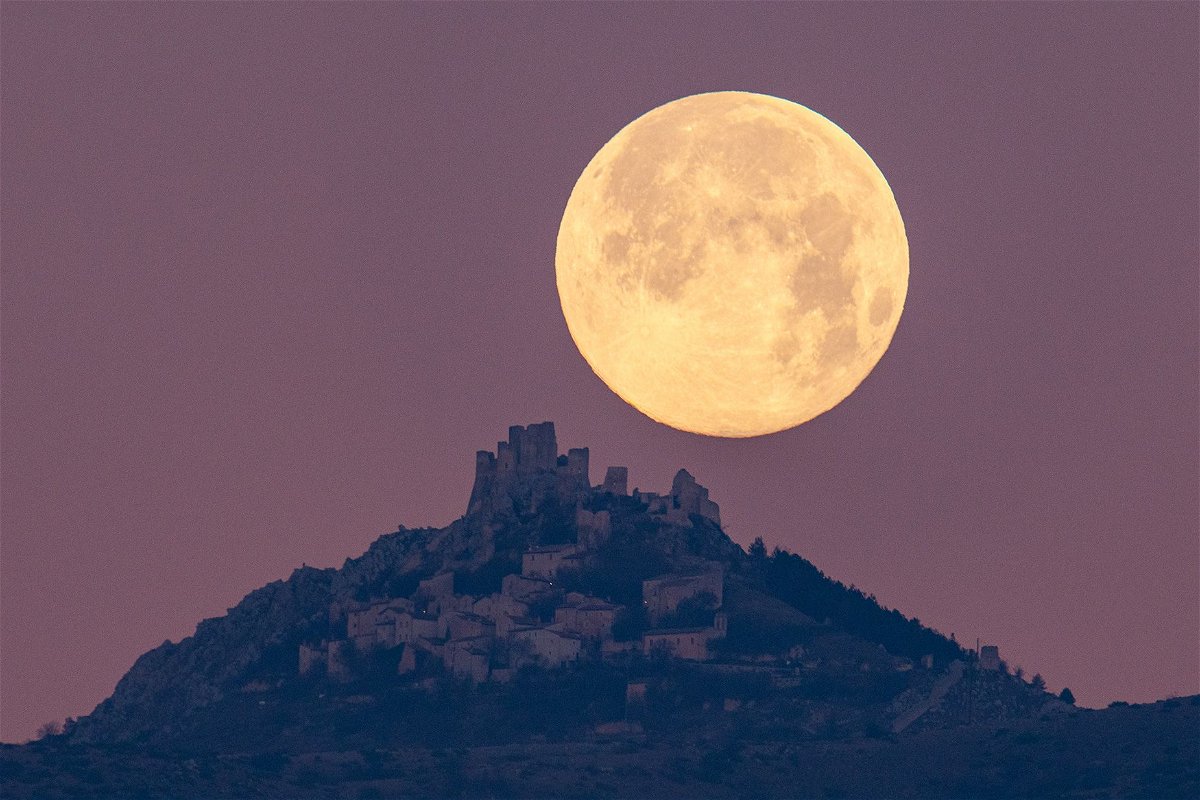Keep an eye on the sky for January’s full ‘wolf moon’

The wolf moon can be seen setting behind the castle of Rocca Calascio in the Abruzzo region of Italy
(CNN) — The first full moon of the new year, known as the wolf moon, will shine in the night sky Thursday.
January’s full moon reached peak illumination at 12:54 p.m. ET, but it will appear full through Friday evening, according to NASA.
Expect the bright orb to rise in the east around sunset Thursday and appear just about overhead around midnight, according to EarthSky.
Between Thursday evening and Friday morning, the full moon will be close to the bright star Pollux. The star will appear to rotate clockwise around the moon overnight, according to NASA.
January’s full moon is commonly called the wolf moon because wolves are active this time of year and can be heard howling on cold nights, according to the Old Farmer’s Almanac. The origin of the name stems from the Sioux language, which describes this moon as “wolves run together.”
But this wintry full moon also goes by many other monikers according to different Native American tribes: It’s known as the cold moon to the Cherokee people, the hard moon to the Lakota and the whirling wind moon to the Passamaquoddy tribe.
The full moon will be visible around the world, weather permitting, so bundle up to stay warm and enjoy the view. Here are other celestial events to look forward to this year.
Full moons
Of the 12 full moons in 2024, September and October’s lunar events will be considered supermoons, according to EarthSky.
Definitions of a supermoon can vary, but the term generally denotes a full moon that is closer to Earth than normal and thus appears larger and brighter in the night sky. Some astronomers say the phenomenon occurs when the moon is within 90% of perigee — its closest approach to Earth in orbit.
Here are the remaining full moons of 2024:
February 24: Snow moon
March 25: Worm moon
April 23: Pink moon
May 23: Flower moon
June 21: Strawberry moon
July 21: Buck moon
August 19: Sturgeon moon
September 17: Harvest moon
October 17: Hunter’s moon
November 15: Beaver moon
December 15: Cold moon
Solar and lunar eclipses
Multiple eclipses will occur in 2024, including two types of lunar eclipses and two types of solar eclipses, according to the Old Farmer’s Almanac.
The most highly anticipated of these events is the total solar eclipse occurring on April 8, which will be visible to those in Mexico, the United States and Canada. A total solar eclipse occurs when the moon passes between Earth and the sun, completely blocking the golden orb’s face.
Those within the path of totality, or locations where the moon’s shadow will completely cover the sun, will see a total solar eclipse.
People outside the path of totality will still be able to see a partial solar eclipse, in which the moon only obscures part of the sun’s face.
A total solar eclipse won’t be visible across the contiguous US again until August 2044.
An annular solar eclipse will occur in the sky on October 2 over parts of South America. This type of eclipse is similar to a total solar eclipse, except the moon is at the farthest point in its orbit from Earth, so it can’t completely block the sun. Instead, annular solar eclipses create a “ring of fire” in the sky as the sun’s fiery light surrounds the moon’s shadow.
Meanwhile, a penumbral lunar eclipse will be visible to many across Europe, North and East Asia, Australia, Africa, North America, and South America between March 24 and 25.
A lunar eclipse, which causes the moon to look dark or dimmed, occurs when the sun, Earth and moon align so that the moon passes into Earth’s shadow. A penumbral lunar eclipse is more subtle and happens when the moon moves through the outer shadow, or penumbra, of Earth.
A partial lunar eclipse, in which Earth moves between the sun and the full moon without being perfectly aligned, will appear over Europe and much of Asia, Africa, North America and South America between September 17 and 18.
Check Time and Date’s website to see when each of these eclipses will appear.
Meteor showers of 2024
Sky-gazers can look forward to a multitude of meteor showers this year, according to the American Meteor Society. Here are the dates when meteor events are expected to peak this year.
Lyrids: April 21-22
Eta Aquariids: May 4-5
Southern delta Aquariids: July 29-30
Alpha Capricornids: July 30-31
Perseids: August 11-12
Draconids: October 7-8
Orionids: October 20-21
Southern Taurids: November 4-5
Northern Taurids: November 11-12
Leonids: November 17-18
Geminids: December 13-14
Ursids: December 21-22
The-CNN-Wire
™ & © 2024 Cable News Network, Inc., a Warner Bros. Discovery Company. All rights reserved.


